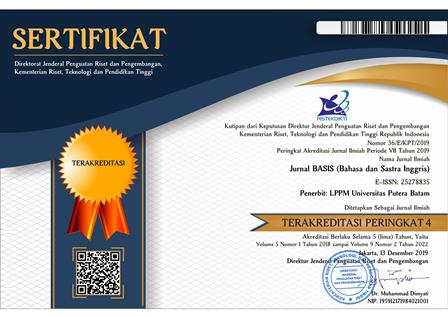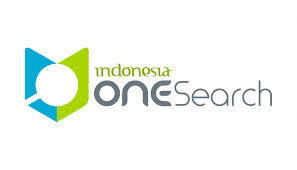MEETING ROOMS NAMING IN EAST JAVA GOVERNMENTAL BUILDING: A STUDY OF ANTHROPOLOGICAL LINGUSITICS
DOI:
https://doi.org/10.33884/basisupb.v7i2.2436Keywords:
naming, institutional, anthropological linguisticsAbstract
Naming is a specific linguistic act, intimately linked with values, traditions, hopes, fears and events in people’s lives. Names reveal the many preferences of their owners (or givers) in terms of real life objects, actions, features and beliefs. Place names provide the most useful geographical reference system in the world. The topic of names is a multidisciplinary field that has occupied the attention of philosophers of language, anthropologists, linguists and ordinary people. In this study, I try to analyze the names of meeting rooms in the East Java Governmental Building. The reason to choose this object is because the East Java Governmental Building is the center of government/ administration in East Java. This study aims to find out the kinds of names applied in the naming of meeting rooms in the East Java Governmental Building and the presuppose reasons behind the name chosen of the East Java Governmental Building. This study is a qualitative study. Based on the classification of the data, they were classified to two groups: the names of governors in East Java and the names of the kings or military chief of great kingdoms in East Java. The meeting rooms in the governmental building of East Java are named after important people in the history of the province. To conclude, the administration named all the meeting rooms, as the most important rooms in the building to welcome guests, using the name of people who have big influence and involvement in the history of East Java so that it has roots to its history.
References
Ainiala, Terhi, Minna Saarelma, and Paula Sjoblom. Names in Focus. Helsinki: Studia Fennica Linguistica, 2016.
Alford, R. D. (1987). Naming and identity: A cross-cultural study of personal naming practices. New Haven, Connecticut: HRAF Press.
Al-Zumor, Abdul. "A Socio-Cultural and Linguistic Analysis of Yemeni Arabic Personal." GEMA Online Journal of Language Studies, 2009: 15-27.
Auda, I. D. (2003). Period Arabic names and naming practices. Proceedings of the Known World Heraldic Symposium (pp. 42-56) St. Louis, USA.
Ameliza, Thessa Cynthia; Ambalegin, Ambalegin. (2020) Code Switching Analysis In English Literature Whatsapp Group. Jurnal Basis, [S.L.], V. 7, N. 1, P. 141-150, Apr. 2020. Issn 2527-8835. Available At: Http://Ejournal.Upbatam.Ac.Id/Index.Php/Basis/Article/View/1837
Foley, William A. "Anthropological Linguistics." The Encyclopedia of Applied Linguistics, 2012: 1-6.
Koul, O. N. (1995). Personal names in Kashmiri. In Omkar N. Koul (ed.) Sociolinguistics: South Asian perspectives. New Delhi: Creative Books.
Ogie, O. (2002). Edo personal names and world view. In Ohioma I. Pogosan and Francis
O. Egbokhare. (Eds.), New perspectives in Edoid studies: Essays in honour of Ronald Peter Schaefer. Cape Town RSA: Centre for Advanced Studies of African Society, Book Series no.20
Pamungkas, Kasno, and Rizky Abdulah. "Linguistics-Based Pharmaceutical Product Naming Methods: A Morphological Study on Over the Counter Medicine Products in Indonesia." Asian Journal of Pharmaceutical and Clinical Research, 2017: 108-112.
Prasetyoaji, Anggihat. (2020) Transivity On Elon Musk’s Online Biography:A Social Actors Discourse Analysis. Jurnal Basis, [S.L.], V. 7, N. 1, P. 13-24, Apr. 2020. Issn 2527-8835. Available At: <Http://Ejournal.Upbatam.Ac.Id/Index.Php/Basis/Article/View/1673
Rochmawati, Desi. (2020) The Nursing Students Need Of Learning Media For Learning English. Jurnal Basis, [S.L.], V. 7, N. 1, P. 33-46, Apr. 2020. Issn 2527-8835. Available At: <Http://Ejournal.Upbatam.Ac.Id/Index.Php/Basis/Article/View/1816
Rosenhouse, J. (2002). Personal names in Hebrew and Arabic: Modern trends compared to the past. Journal of Semetic Studies, XLVII (1), 97-114.
Sharma, D. D. (2005). Panorama of Indian anthroponomy: An historical, socio-cultural and linguistic analysis of Indian personal names. New Delhi: Mittal.
Simanjuntak, Dairi Sapta Rindu.(2015) Penerapan Teori Antropolinguistik Modern (Competence, Performance, Indexicality, & Partisipation) Dalam Umpasa Budaya Batak Toba. Jurnal Basis, [S.L.], V. 2, N. 2, P. 71-78, Oct. 2015. Issn 2527-8835. Available At: <Http://Ejournal.Upbatam.Ac.Id/Index.Php/Basis/Article/View/407
Wikipedia. (2020). “Toponymy”. (Online) Retrieved 4 October, 2020 from https://en.wikipedia.org/wiki/Toponymy#:~:text=Toponymy%20or%20toponomastics%20is%20the,is%20referred%20to%20as%20toponomastics
Williams, Carrie. "Research Methods." Journal of Business & Economic Research, 2007: 65-72.
Downloads
Published
Issue
Section
License

















